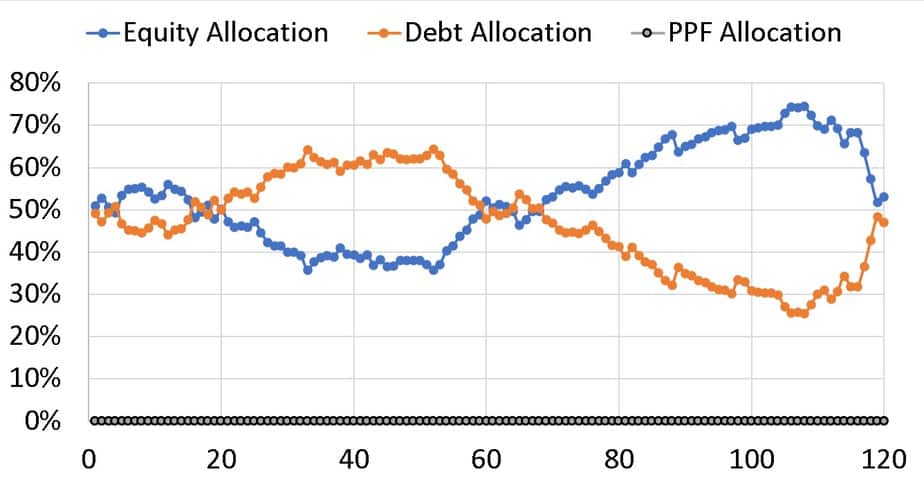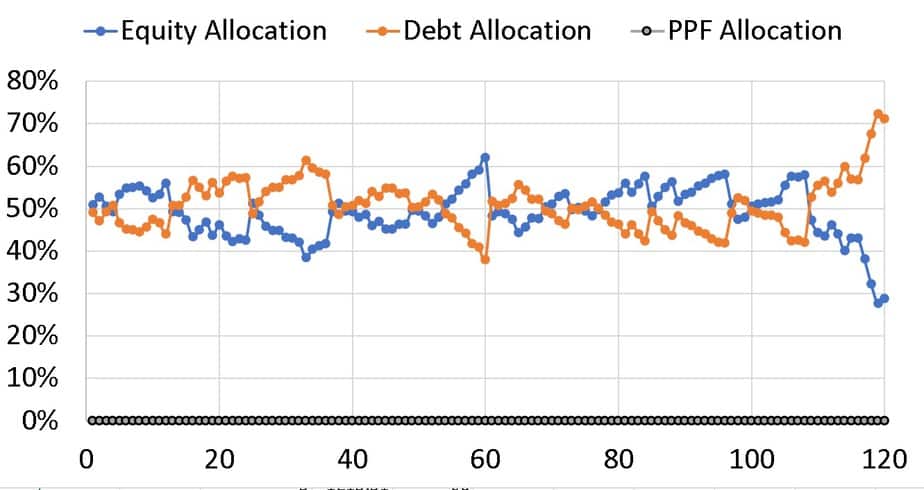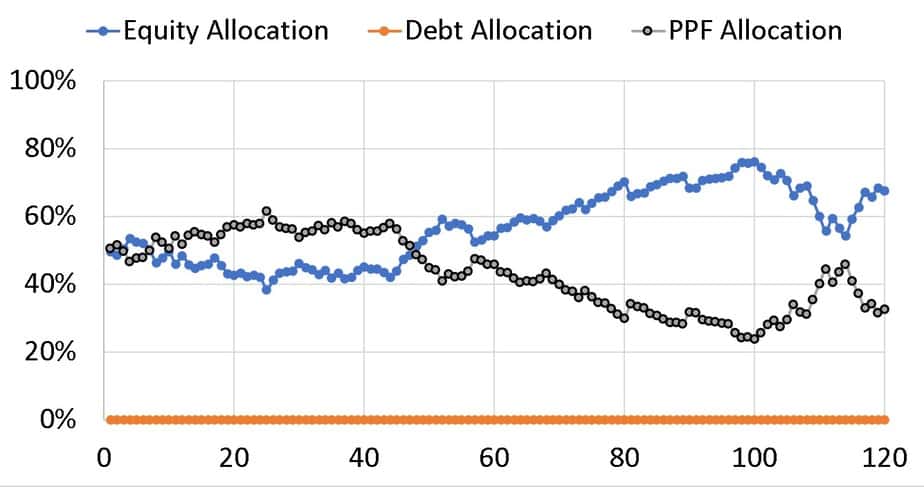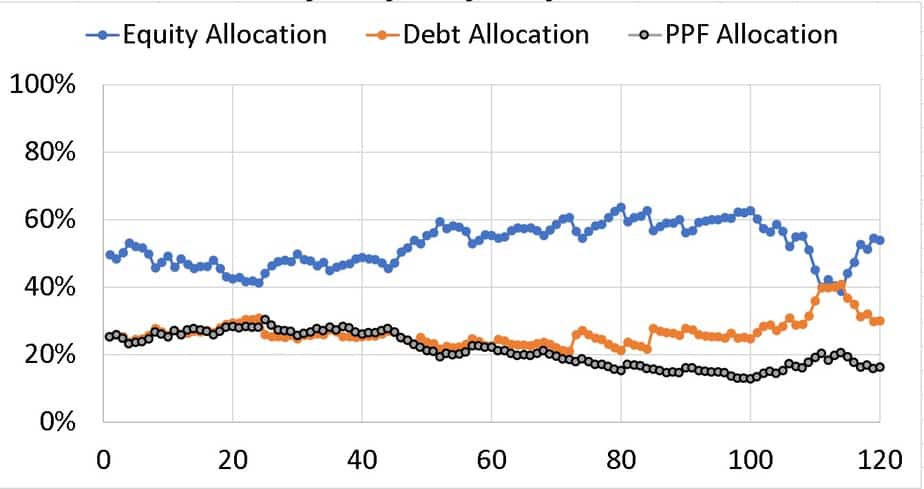Last Updated on December 29, 2021 at 5:31 pm
“I fail to see the need for debt funds when we can invest in safe options like EPF, VPF, PPF, SSY, insurance policies, FD, and RDs. Some are even tax-free!” The Franklin debt fund closure naturally triggers questions such as this. The problem is, every choice has a risk. When we seek safety we mean safety from only one kind of risk and that may prove to be riskier!
Even a casual attempt at using a retirement calculator would tell you that the investment amount is a big number and this a return greater than inflation! Running to the safety of fixed income would only make things worse.
Every option available has a risk. FDs and RDs require tax to be paid as per slab each year with gradually falling interest rates which can only get worse in future (reinvestment risk).
Join 32,000+ readers and get free money management solutions delivered to your inbox! Subscribe to get posts via email! (Link takes you to our email sign-up form)
🔥Want to create a complete financial plan? Learn goal-based investing? Exclusive access to our DIY tools? Increase your income with your skills? Use this link to enjoy massive discounts on our robo-advisory tool & courses! 🔥
Insurance policies are too expensive leaving little for investing elsewhere. Remember a good amount of equity is necessary for any kind of chance against inflation.
Overnight funds are too conservative for long term goals and suffer the highest reinvestment risk: Overnight Mutual Funds also have risks! What investors need to know
Liquid funds are also too conservative for long term goals, also suffer from reinvestment risk and can be volatile in time likes these: Why Liquid funds and money market funds also fell in the last few days
If we skip all other debt funds and consider only gilt funds, actively managed gilt funds suffer from fund manager risk when they shift asset allocation bet gilts and non-gilts as per market conditions. They suffer from interest rate risk and are volatile.
10-year constant maturity gilt funds have little fund manager risk, the closest we have to a gilt index fund but are the most volatile and can frustrate buyers with long periods of poor returns.
Our good old PPF can only be used for 15Y-plus goals, cannot be redeemed from at will. Similar constraints also apply to EPF, VPF and SSY. “Why must I worry about lock-in? After all, the goal is for the long term, is it not?”
That is the problem. Use only these for the long term and you end will less purchasing power because of inflation. Use only a little equity and inflation will hit you again. Most people simply do not have the money to compensate for safety with higher investments.
As an example, Rs. 1000 invested at 9% (annualized) for 16 years would give you 3.6 times the investment. If you want the same benefit with safer 7% return, you will have to invest 32% more. If we include tax, it will only make things worse.
All well to say, I am going to avoid X or Y instrument and stick to safe FDs and RDs but there is always a cost. Now the following would make sense to only those who appreciate the benefits of asset allocation.
Most investors who are 35-plus today would have an EPF + PPF debt-heavy allocation for long-term goals. They have little chance of correcting (most do not wish to anyway) and it will affect the way they live after retirement.
The following illustration is for a young earner with not too much invested in EPF and can sooner than later get to an asset allocation of 50% equity and 50% fixed income for a long term goal like retirement.
Consider a portfolio with 50% equity and 50% liquid fixed income. That is, say a gilt debt fund which one can redeem or invest in freely. If the portfolio is not rebalanced (asset allocation reset to 50:50) once a year it can drift like this. The first 120 months (10 years) movement is shown below.

The asset allocation can swing towards equity or debt both of which can increase the risk of not achieving our goals. With annual rebalancing, the swings are significantly lower.

Now with 50% equity and 50% PPF, rebalancing is not possible (at least not each year and not to the full extent).

In the above example, 50% of equity can move close to 80% increasing portfolio risk. If one argues the amount can be removed to say an SB account and then put back in, then they have realised the value of liquid debt!
This is 50% equity, 25% PPF and 25% long-term gilts with annual rebalancing for the same return sequence. Notice the reduction in deviations. The rebalancing here is done only bet the equity and gilt component.

The reason for choosing gilts and not just an SB account or liquid fund is their volatility, they providing selling and buying opportunities like equity and times could coincide with the buying and selling opportunity in equity (as observed from asset allocation variations). This would lower risk.
What should young investors do?
- Do not lock your money into bonds and deposits
- Do not maximise PPF or VPF without looking at your asset allocation. You may forever destroy your ability to beat inflation and reach your desired target corpus and increase portfolio risk if equity exposure is reasonable.
- Have room for liquid fixed income in your portfolio. If scared of debt funds and arbitrage funds (which also have bonds) use long term gilts. Instead of worrying about their volatility, exploit it to reduce portfolio risk.
There is always a risk in every option. That is why there is no best option. Like every successful marriage, comprise is the key. Which risks can I accept so that the investment amount is reasonable, will keep portfolio risk at manageable levels and will take me close to my goal with minimal maintenance. The answer to this question is the holy grail of investing and varies from person to person!

Use our Robo-advisory Tool to create a complete financial plan! ⇐More than 3,000 investors and advisors use this! Use the discount code: robo25 for a 20% discount. Plan your retirement (early, normal, before, and after), as well as non-recurring financial goals (such as child education) and recurring financial goals (like holidays and appliance purchases). The tool would help anyone aged 18 to 80 plan for their retirement, as well as six other non-recurring financial goals and four recurring financial goals, with a detailed cash flow summary.
🔥You can also avail massive discounts on our courses and the freefincal investor circle! 🔥& join our community of 8000+ users!
Track your mutual funds and stock investments with this Google Sheet!
We also publish monthly equity mutual funds, debt and hybrid mutual funds, index funds, and ETF screeners, as well as momentum and low-volatility stock screeners.
You can follow our articles on Google News

We have over 1,000 videos on YouTube!

Join our WhatsApp Channel



- Do you have a comment about the above article? Reach out to us on Twitter: @freefincal or @pattufreefincal
- Have a question? Subscribe to our newsletter using the form below.
- Hit 'reply' to any email from us! We do not offer personalised investment advice. We can write a detailed article without mentioning your name if you have a generic question.
Join 32,000+ readers and get free money management solutions delivered to your inbox! Subscribe to get posts via email! (Link takes you to our email sign-up form)
About The Author
 Dr M. Pattabiraman (PhD) is the founder, managing editor and primary author of freefincal. He is an associate professor at the Indian Institute of Technology, Madras. He has over 13 years of experience publishing news analysis, research and financial product development. Connect with him via Twitter(X), LinkedIn, or YouTube. Pattabiraman has co-authored three print books: (1) You can be rich too with goal-based investing (CNBC TV18) for DIY investors. (2) Gamechanger for young earners. (3) Chinchu Gets a Superpower! for kids. He has also written seven other free e-books on various money management topics. He is a patron and co-founder of “Fee-only India,” an organisation promoting unbiased, commission-free, AUM-independent investment advice.
Dr M. Pattabiraman (PhD) is the founder, managing editor and primary author of freefincal. He is an associate professor at the Indian Institute of Technology, Madras. He has over 13 years of experience publishing news analysis, research and financial product development. Connect with him via Twitter(X), LinkedIn, or YouTube. Pattabiraman has co-authored three print books: (1) You can be rich too with goal-based investing (CNBC TV18) for DIY investors. (2) Gamechanger for young earners. (3) Chinchu Gets a Superpower! for kids. He has also written seven other free e-books on various money management topics. He is a patron and co-founder of “Fee-only India,” an organisation promoting unbiased, commission-free, AUM-independent investment advice.Our flagship course! Learn to manage your portfolio like a pro to achieve your goals regardless of market conditions! ⇐ More than 3,500 investors and advisors are part of our exclusive community! Get clarity on how to plan for your goals and achieve the necessary corpus no matter the market condition!! Watch the first lecture for free! One-time payment! No recurring fees! Life-long access to videos! Reduce fear, uncertainty and doubt while investing! Learn how to plan for your goals before and after retirement with confidence.
Increase your income by getting people to pay for your skills! ⇐ More than 800 salaried employees, entrepreneurs and financial advisors are part of our exclusive community! Learn how to get people to pay for your skills! Whether you are a professional or small business owner seeking more clients through online visibility, or a salaried individual looking for a side income or passive income, we will show you how to achieve this by showcasing your skills and building a community that trusts and pays you. (watch 1st lecture for free). One-time payment! No recurring fees! Life-long access to videos!
Our book for kids: “Chinchu Gets a Superpower!” is now available!


Must-read book even for adults! This is something that every parent should teach their kids right from their young age. The importance of money management and decision making based on their wants and needs. Very nicely written in simple terms. - Arun.Buy the book: Chinchu gets a superpower for your child!
How to profit from content writing: Our new ebook is for those interested in getting a side income via content writing. It is available at a 50% discount for Rs. 500 only!
Do you want to check if the market is overvalued or undervalued? Use our market valuation tool (it will work with any index!), or get the Tactical Buy/Sell timing tool!
We publish monthly mutual fund screeners and momentum, low-volatility stock screeners.
About freefincal & its content policy. Freefincal is a News Media organisation dedicated to providing original analysis, reports, reviews and insights on mutual funds, stocks, investing, retirement and personal finance developments. We do so without conflict of interest and bias. Follow us on Google News. Freefincal serves more than three million readers a year (5 million page views) with articles based only on factual information and detailed analysis by its authors. All statements made will be verified with credible and knowledgeable sources before publication. Freefincal does not publish paid articles, promotions, PR, satire or opinions without data. All opinions will be inferences backed by verifiable, reproducible evidence/data. Contact Information: To get in touch, please use our contact form. (Sponsored posts or paid collaborations will not be entertained.)
Connect with us on social media
- Twitter @freefincal
- Subscribe to our YouTube Videos
- Posts feed via Feedburner.
Our publications
You Can Be Rich Too with Goal-Based Investing
 Published by CNBC TV18, this book is designed to help you ask the right questions and find the correct answers. Additionally, it comes with nine online calculators, allowing you to create custom solutions tailored to your lifestyle. Get it now.
Published by CNBC TV18, this book is designed to help you ask the right questions and find the correct answers. Additionally, it comes with nine online calculators, allowing you to create custom solutions tailored to your lifestyle. Get it now.Gamechanger: Forget Startups, Join Corporate & Still Live the Rich Life You Want
 This book is designed for young earners to get their basics right from the start! It will also help you travel to exotic places at a low cost! Get it or gift it to a young earner.
This book is designed for young earners to get their basics right from the start! It will also help you travel to exotic places at a low cost! Get it or gift it to a young earner.Your Ultimate Guide to Travel
 This is an in-depth exploration of vacation planning, including finding affordable flights, budget accommodations, and practical travel tips. It also examines the benefits of travelling slowly, both financially and psychologically, with links to relevant web pages and guidance at every step. Get the PDF for Rs 300 (instant download)
This is an in-depth exploration of vacation planning, including finding affordable flights, budget accommodations, and practical travel tips. It also examines the benefits of travelling slowly, both financially and psychologically, with links to relevant web pages and guidance at every step. Get the PDF for Rs 300 (instant download)